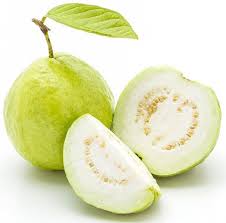Crop Production - Nutrition & INM
Guava (Psidium guajava): Guava is an excellent source of vitamin C. Since guava bears almost throughout the year, proper doses of nutrient application is considered essential for maintaining the productivity and good health of the tree.
-
 Nutrition: Guava responds well to the application of both organic
manures and inorganic fertilizers in terms of increased
growth, fruit yield and quality. Experiments conducted
on nutrient requirement of guava in different parts of
the country have indicated that this depends on many
factors such as variety, climate, soil type, cropping
pattern and intensity of cropping based on which
empirical general recommendations were given regarding
the fertilizer doses as indicated below:
Nutrition: Guava responds well to the application of both organic
manures and inorganic fertilizers in terms of increased
growth, fruit yield and quality. Experiments conducted
on nutrient requirement of guava in different parts of
the country have indicated that this depends on many
factors such as variety, climate, soil type, cropping
pattern and intensity of cropping based on which
empirical general recommendations were given regarding
the fertilizer doses as indicated below: -
State
N, P, K g/tree
West Bengal
260-454 g N + 160-260 g P2O5 + 260 g K2O
Uttar Pradesh
60 g N + 40 g P + 40 g K
Tamil Nadu
1 kg N + 1 kg P + 1 Kg K
Bangalore
900 g N + 600 g P + 600 g K
Bihar
500 g N + 300 g P2O5 + 600 g K2O
Maharashtra
600 g N + 300 g P + 300 g K
The fertilizers may be applied in two split doses,
preferably in June and October, in a ring which covers an area
of 30 cm away from the trunk to the drip line. Soil should
be dug to a depth of 8 to 10 cm to properly mix the fertilizers
with the soil. Foliar application of micronutrients along with 2
– 6% urea also increases the vegetative growth, fruit yield and
fruit quality. Deficiencies of zinc and boron are common in
guava. Soil application of 800 g ZnSO4
/ tree or foliar spray of 0.5 per
cent ZnSO4 and 0.4 percent boric acid 10 to
14 days before every flowering, is effective in
eliminating the deficiencies. Sampling
recently matured (50-60 days old) leaf
of 3rd pair from the growing tip during
July-August or November-December is recommended for leaf
analysis. The relationship between fertilizer practices,
leaf composition, yield and fruit quality were not
sufficient to suggest leaf nutrient standards as it
depends upon many factors like cropping pattern,
cropping intensity, season and varieties, but the
following optimum nutrient ranges are suggested in
general as leaf nutrient guides:
|
Nutrient |
Ranges |
|
N |
1.4 to 2.0% |
|
P |
0.20 to 0.40% |
|
K |
1.31 to 1.70% |
|
Ca |
0.67 to 3.0% |
|
Mg |
0.25 to 0.68% |

